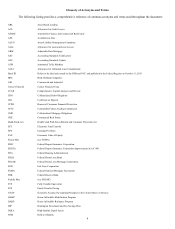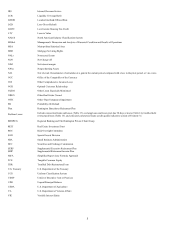Huntington National Bank 2014 Annual Report Download - page 20
Download and view the complete annual report
Please find page 20 of the 2014 Huntington National Bank annual report below. You can navigate through the pages in the report by either clicking on the pages listed below, or by using the keyword search tool below to find specific information within the annual report.
14
Failure to meet applicable capital guidelines could subject the financial institution to a variety of enforcement remedies available
to the federal regulatory authorities. These include limitations on the ability to pay dividends, the issuance by the regulatory authority
of a directive to increase capital, and the termination of deposit insurance by the FDIC. In addition, the financial institution could be
subject to the measures described below under Prompt Corrective Action as applicable to under-capitalized institutions.
The risk-based capital standards of the Federal Reserve, the OCC, and the FDIC specify that evaluations by the banking agencies
of a bank's capital adequacy will include an assessment of the exposure to declines in the economic value of a bank's capital due to
changes in interest rates. These banking agencies issued a joint policy statement on interest rate risk describing prudent methods for
monitoring such risk that rely principally on internal measures of exposure and active oversight of risk management activities by
senior management.
FDICIA requires federal banking regulatory authorities to take Prompt Corrective Action with respect to depository institutions
that do not meet minimum capital requirements. For these purposes, FDICIA establishes five capital tiers: well-capitalized,
adequately-capitalized, under-capitalized, significantly under-capitalized, and critically under-capitalized.
Throughout 2014, our regulatory capital ratios and those of the Bank were in excess of the levels established for well-capitalized
institutions. An institution is deemed to be well-capitalized if it has a total risk-based capital ratio of 10% or greater, a Tier 1 risk-
based capital ratio of 6% or greater, and a Tier 1 leverage ratio of 5% or greater and is not subject to a regulatory order, agreement, or
directive to meet and maintain a specific capital level for any capital measure.
At December 31, 2014
Well-capitalized Excess
(dollar amounts in billions) minimums Actual Capital (1)
Ratios:
Tier 1 leverage ratio Consolidated 5.00 % 9.74 % $ 3.0
Bank 5.00 9.56 2.9
Tier 1 risk-based capital ratio Consolidated 6.00 11.50 3.0
Bank 6.00 11.28 2.9
Total risk-based capital ratio Consolidated 10.00 13.56 1.9
Bank 10.00 12.79 1.5
(1) Amount greater than the well-capitalized minimum percentage.
FDICIA generally prohibits a depository institution from making any capital distribution, including payment of a cash dividend or
paying any management fee to its holding company, if the depository institution would become under-capitalized after such payment.
Under-capitalized institutions are also subject to growth limitations and are required by the appropriate federal banking agency to
submit a capital restoration plan. If any depository institution subsidiary of a holding company is required to submit a capital
restoration plan, the holding company would be required to provide a limited guarantee regarding compliance with the plan as a
condition of approval of such plan.
Depending upon the severity of the under capitalization, the under-capitalized institutions may be subject to a number of
requirements and restrictions, including orders to sell sufficient voting stock to become adequately-capitalized, requirements to reduce
total assets, cessation of receipt of deposits from correspondent banks, and restrictions on making any payment of principal or interest
on their subordinated debt. Critically under-capitalized institutions are subject to appointment of a receiver or conservator within 90
days of becoming so classified.
Under FDICIA, a depository institution that is not well-capitalized is generally prohibited from accepting brokered deposits and
offering interest rates on deposits higher than the prevailing rate in its market. Since the Bank is well-capitalized, the FDICIA
brokered deposit rule did not adversely affect its ability to accept brokered deposits. The Bank had $2.2 billion of such brokered
deposits at December 31, 2014.
On September 3, 2014, the U.S. banking regulators approved a final rule to implement a minimum liquidity coverage ratio (LCR)
requirement for banking organizations with total consolidated assets of $250 billion or more, and a less stringent modified LCR
requirement to depository institution holding companies below the threshold but with total consolidated assets of $50 billion or more.
The LCR requires covered banking organizations to maintain HQLA equal to projected stressed cash outflows over a 30 calendar-day
stress scenario. We are covered by the modified LCR requirement and therefore subject to the phase-in of the rule beginning January
2016 at 90% and January 2017 at 100%. We will also be required to calculate the LCR monthly.
























